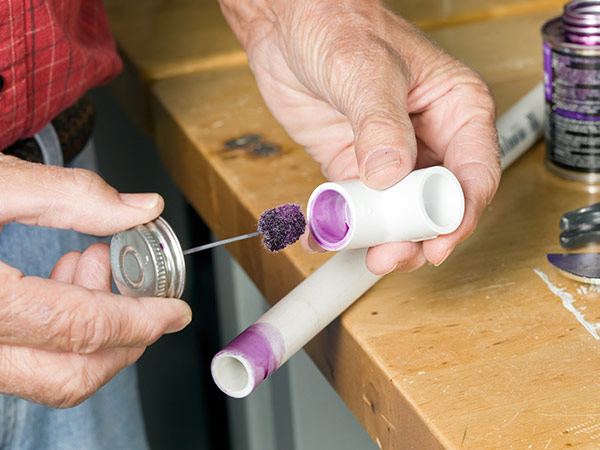

PVC Hacks to Make Your Project Easier
If you're an avid DIYer, odds are you've had to work with PVC pipe to complete a project and you're always searching for new ways to get things done. If you want PVC hacks that go beyond a cute craft project, keep these tips of the trade in your back pocket to get the job done faster and easier.
What Exactly is PVC?

PVC or polyvinyl chloride is one of the most widely produced plastics in the world and is used to make PVC plumbing pipe.
Different thickness of pipe is classified by “schedule”. The most popular schedule for plumbing applications is Schedule 40.
PVC pipe can also be specified for different usages:
- CPVC pipes are for higher water temperatures
- DWV PVC is made for drain, waste, and vent applications
“Fittings” for PVC pipe are the connectors needed to keep pipes together and keep water flowing. These come in a variety of shapes and sizes. Pipes and their fittings are primed and glued together to create a complete seal.

12 PVC Hacks for an Easy Project
- Working with PVC in a tight space. Currently installed PVC pipe can be difficult to cut and refit in tight spaces where a saw won't fit. Nylon string can be used to cut pipe by wrapping it around and pulling back and forth. A little force on the string will cut your pipe all the way through.
- Moving heavy objects. Use lengths of PVC pipe to move heavy objects. Carefully slide your object on top of the pipe. Continuously add a roller underneath the moving front end of the object to keep it rolling. You’ll be moving the one closest to you to the front as the object rolls forward. You need at least three pieces for this. Be sure to pick a very sturdy pipe for larger objects.
- Working outside with PVC. When using PVC primer and glue outside, start the application on the inside of a fitting first before the outside of the pipe. This minimizes the amount of time wind could blow dust into the prime or glue. A clean circle of glue ensures a proper hold and seal.
- Cutting PVC. When cutting PVC pipe with mechanical saws, use metal-cutting blades or dull wood-cutting blades. The large teeth of new wood-cutting blades create burrs or jagged edges easily.
- Smoothing jagged edges. Cut pipe has jagged edges that need to be smoothed or "deburred" to avoid debris getting caught and causing a blockage. If you don't have a deburring tool, run the blade of a pocketknife along the end to remove the jagged edges.
- Reusing old PVC pipe. One of the great things about PVC is that it is long-lasting and can be reused. To create a solid new connection with glue, the pipe needs to be cleaned of any dirt. Lightly sand away the dirt with a fine-grit sandpaper before adding glue.
- Maximizing storage. Use pieces of PVC pipe to hold caulking tubes, tools, or even small items like pens and rulers. Pipes can even be secured to a garage workstation headboard, on drywall, or between studs.
- Ensuring proper fit and seal. Double check your pipe fittings before you glue by dry fitting them together. From there, use a marker to draw a line on the pipe and fitting where curves and bends need the most accurate fit. As you glue them together, ensure your marks are properly lined up.
- Keeping water at temperature. When working on water lines, wrap your completed job with pipe insulation. This will keep water cooler in the summer and warmer in the winter.
- Working with wastewater. Use only DWV (drain, waste, and vent) PVC pipe to carry water from drains. DWV elbows and bends are designed with rounder curves to help guide waste through them.
- Sander for curved spots. If you have a curved section of wood that you are trying to sand but are finding it difficult to sand on a curve evenly, grab some old pieces of PVC pipe. If you have several sizes of pipe, you can find the perfect fit to the size of the area you are trying to sand. Either using adhesive-backed sandpaper or spray glue and sandpaper, fit the piece around the pipe and press down until dry. The curve on the pipe will give you an even curve to sand with. You can even cut the pipe in half lengthwise and glue the sandpaper to the inside curve for a concave sander.
- Bucket notches in a pinch. If you don’t have a workbench to stabilize your pipe while you cut it to length, you can use a plastic five-gallon bucket instead. Cut one v-notch into the top of your bucket on either side of the opening. The opening of your notch should be slightly wider than your pipe size, so it fits snugly and stays put while you are cutting. Place your PVC pipe into your notches and now you have a safe way to cut your pipe.
PVC Projects with McCoy's
McCoy’s is here to help with all your PVC project needs. We carry a variety of schedule 40 PVC pipe and fittings, CPVC, and DWV. McCoy’s has the tools and accessories to complete your project including PVC primer and glue. Stop by in store or shop online today!
